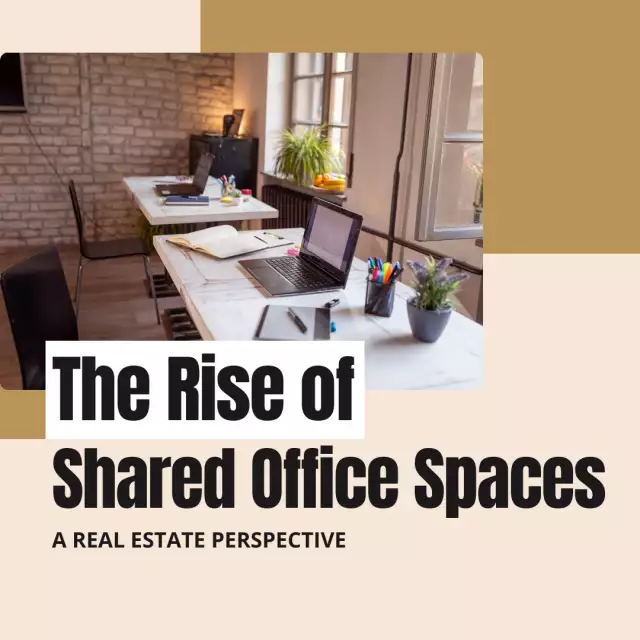The Rise of Shared Office Spaces: A Real Estate Perspective
The Rise of Shared Office Spaces: A Real Estate Perspective
In recent years, the concept of shared office spaces has taken the business world by storm. Gone are the days when traditional offices were the only option for entrepreneurs, freelancers, and small businesses. Shared office spaces, also known as coworking spaces, have emerged as a popular alternative that offers numerous benefits for professionals. This blog post explores the rise of shared office spaces from a real estate perspective, highlighting the key factors contributing to their popularity and the impact they have on the real estate industry.
The Changing Nature of Work:The rise of shared office spaces can be attributed to the changing nature of work itself. With the advent of technologyand the rise of remote work, traditional office spaces no longer meet the needs of modern professionals. Shared office spaces provide flexible and collaborative environments that cater to the diverse work styles and preferences of individuals and businesses.
Cost-effectiveness:One of the major factors driving the popularity of shared office spaces is their cost-effectiveness. Traditional office leases often involve long-term commitments, high upfront costs, and ongoing expenses for maintenance, utilities, and administrative staff. In contrast, shared office spaces offer flexible membership options, allowing professionals to pay for only the space and services they need. This affordability makes it an attractive option for startups, freelancers, and small businesses looking to optimize their operational costs.
Networking and Collaboration Opportunities:Shared office spaces foster a sense of community and provide ample opportunities for networking and collaboration. Professionals from different industries and backgrounds work side by side, creating a dynamic environment that encourages idea-sharing and partnerships. This collaborative atmosphere often leads to increased creativity, innovation, and business opportunities for individuals and organizations utilizing shared office spaces.
Amenities and Services:Shared office spaces are designed to provide a range of amenitiesand services that enhance productivity and convenience for occupants. These spaces typically offer high-speed internet, modern office furniture, meeting rooms, conference facilities, and common areas for relaxation and socialization. Additionally, shared office providers often offer additional services such as reception support, mail handling, printing, and even access to professional events and workshops.
Flexibility and Scalability:Flexibility is a key advantage of shared office spaces. Professionals can choose from a variety of membership options, including hot desks, dedicated desks, or private offices, depending on their needs. This flexibility allows businesses to scale up or downsize without the constraints of long-term leases. As companies grow or contract, they can easily adjust their space requirements within the shared office environment, avoiding the hassle and financial burden of relocating.
Real Estate Industry Impact:The rise of shared office spaces has significantly impacted the real estate industry. Traditional office space providers have had to adapt to the changing demands of the market by incorporating coworking options into their portfolios. Landlords and property developers are increasingly considering shared office spaces as a viable option to maximize their property's utilization and appeal to a broader range of tenants. This shift has resulted in the transformation of underutilized or vacant commercial spaces into vibrant shared office environments.
Conclusion
Shared office spaces have revolutionized the way professionals work, offering an innovative and flexible alternative to traditional office spaces. From the real estate perspective, the rise of shared office spaces has presented both challenges and opportunities. The increasing demand for shared office spaces has led to the transformation of the commercial real estate landscape, creating new business models and driving the need for more flexible lease agreements. As the trend continues to grow, it is essential for real estate professionals to adapt and embrace this changing paradigm to stay relevant in the evolving office space market.
FAQs
Q: What exactly is a shared office space?
A: A shared office space, also known as a coworking space, is a flexible workspace that is shared by professionals from different companies or individuals. It provides a collaborative and community-oriented environment with various amenities and services.
Q: How does the rise of shared office spaces impact the real estate industry?
A: The rise of shared office spaces has led traditional office providers to incorporate coworking options into their portfolios. It has also transformed underutilized or vacant commercial spaces into vibrant shared office environments, maximizing property utilization and appealing to a broader range of tenants.
Q: Why are shared office spaces popular among professionals?
A: Shared office spaces offer several advantages, including cost-effectiveness, networking and collaboration opportunities, flexible membership options, and access to amenities and services. These factors make them attractive to startups, freelancers, and small businesses seeking affordable and flexible workspace solutions.
Q: How do shared office spaces contribute to networking and collaboration?
A: Shared office spaces bring professionals from various industries and backgrounds together, creating a dynamic environment for networking and collaboration. The proximity and interaction with other professionals often lead to increased creativity, innovation, and potential business partnerships.
Q: What types of amenities and services are typically available in shared office spaces?
A: Shared office spaces provide a range of amenities and services, including high-speed internet, modern office furniture, meeting rooms, conference facilities, common areas for socializing, reception support, mail handling, printing, and access to professional events and workshops.
Q: How do shared office spaces offer flexibility and scalability?
A: Professionals can choose from different membership options such as hot desks, dedicated desks, or private offices based on their needs. This flexibility allows businesses to scale up or downsize within the shared office space without the constraints of long-term leases or the need to relocate.
These FAQs aim to address some common inquiries related to shared office spaces and their impact on the real estate industry. For more detailed information, it is recommended to refer to the corresponding sections in the blog post.




